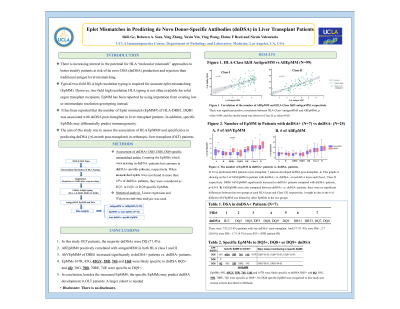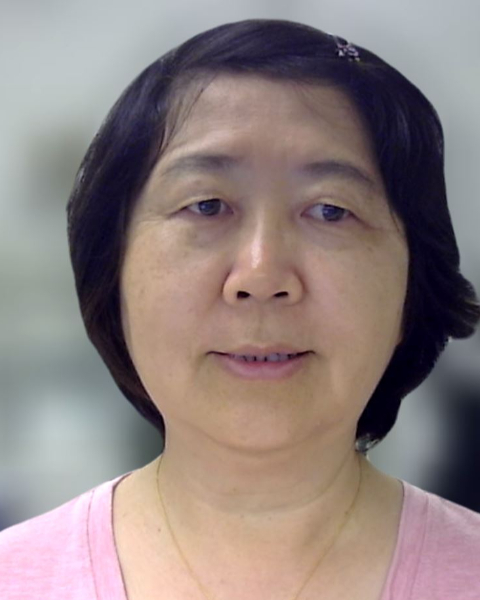Back

Eplet mismatchs in predicting de novo donor-specific antibodies (dnDSA) in liver transplant patients
(P221) Eplet mismatches in predicting de novo donor-specific antibodies (dnDSA) in liver transplant patients
Location: Platinum Ballroom

Poster Presenter(s)
Aim: The development of dnDSA is associated with long term complications in liver transplant (Tx) patients (pts). It has been reported that the number of Eplet mismatch (EpMM#) of HLA-DRB1, DQB1 was associated with dnDSA post-Tx in liver Tx pts. In addition, specific EpMMs may differentially predict immunogenicity. The aim of this study was to assess the association of HLA EpMM#/specificities and dnDSA (≥6M post-Tx) in orthotopic liver Tx (OLT) pts.
Method: Adult OLT pts receiving standard IS therapy were included in this retrospective study. Imputed intermediate resolution (IntR) typing at HLA-A-B-DRB1-DRB3/4/5-DQB1 were obtained for 99 recipient-donor (R-D) pairs. Imputation was performed using HaploStats informed by race and NMDP allele string decoding. FUSION 4.6 HLAMM used. The association of EpMM# and dnDSA was analyzed in 32 pts without pre-Tx DSA. Lastly, dnDSA+ specific EpMMs were assessed for DQ5, DQ8, DQ9, by counting the EpMMs which were missing in dnDSA- pts but common in dnDSA+ pts, respectively. When more than 65% of dnDSA- pts were missing these EpMMs, they were considered as DQ5, or DQ8, or DQ9 specific EpMMs. Linear regression and Wilcoxon rank-sum analysis was used.
Results: AllEpMMs were positively correlated with antigenMMs in both HLA Class I/II in 99 pairs (Figure 1). In 32 pts, 7 (21.9%) developed dnDSA+ [5/7(71.4%) DQ, 1/7 DR51+, 1/7 B13+], 25 (78.1%) dnDSA- . AbVEpMM# significantly increased in pts of dnDSA+ vs. dnDSA- at DRB1: 7.6±2.4 (7, 4-10) vs. 4.6±3.2 (4, 0-12), p=0.02; but there were no differences at HLA-A-B-DRB345-DQB1 between the two groups: 8.1±3.6 (7, 5-16) vs. 5.8±3.7 (8, 0-11), p=0.5; 4.9±1.8 (5, 2-7) vs. 4.8±2.8 (4, 0-9), p=0.9; 2.7±1.6 (3, 0-5) vs. 3.2±2.4 (3, 0-8), p=0.5; 4.6±3.0 (4, 1-9) vs. 4.0±2.9 (4, 0-9), p=0.7, respectively. There were no significant differences in pt age, sex, race and pre-Tx diseases in the two groups. The dnDSA DQ5, DQ8, DQ9 specific EpMMs were listed in Table 1.
Conclusion: In OLT pts, the majority dnDSAs were DQ (71.5%). AllEpmm# positively correlated with antigenMM# in both HLA class I/II. AbVEpMM# of DRB1 increased significantly in dnDSA+ pts vs. dnDSA- pts. EpMMs 167R, 45G, 45GV, 55R, 74S and 116I were likely specific to dnDSA DQ5+ and 4Q, 30G, 70R, 70RE,74E specific to DQ9+. These suggested that besides the increased EpMM#, the specific EpMMs may predict dnDSA development in OLT pts. A larger cohort study is needed.
Method: Adult OLT pts receiving standard IS therapy were included in this retrospective study. Imputed intermediate resolution (IntR) typing at HLA-A-B-DRB1-DRB3/4/5-DQB1 were obtained for 99 recipient-donor (R-D) pairs. Imputation was performed using HaploStats informed by race and NMDP allele string decoding. FUSION 4.6 HLAMM used. The association of EpMM# and dnDSA was analyzed in 32 pts without pre-Tx DSA. Lastly, dnDSA+ specific EpMMs were assessed for DQ5, DQ8, DQ9, by counting the EpMMs which were missing in dnDSA- pts but common in dnDSA+ pts, respectively. When more than 65% of dnDSA- pts were missing these EpMMs, they were considered as DQ5, or DQ8, or DQ9 specific EpMMs. Linear regression and Wilcoxon rank-sum analysis was used.
Results: AllEpMMs were positively correlated with antigenMMs in both HLA Class I/II in 99 pairs (Figure 1). In 32 pts, 7 (21.9%) developed dnDSA+ [5/7(71.4%) DQ, 1/7 DR51+, 1/7 B13+], 25 (78.1%) dnDSA- . AbVEpMM# significantly increased in pts of dnDSA+ vs. dnDSA- at DRB1: 7.6±2.4 (7, 4-10) vs. 4.6±3.2 (4, 0-12), p=0.02; but there were no differences at HLA-A-B-DRB345-DQB1 between the two groups: 8.1±3.6 (7, 5-16) vs. 5.8±3.7 (8, 0-11), p=0.5; 4.9±1.8 (5, 2-7) vs. 4.8±2.8 (4, 0-9), p=0.9; 2.7±1.6 (3, 0-5) vs. 3.2±2.4 (3, 0-8), p=0.5; 4.6±3.0 (4, 1-9) vs. 4.0±2.9 (4, 0-9), p=0.7, respectively. There were no significant differences in pt age, sex, race and pre-Tx diseases in the two groups. The dnDSA DQ5, DQ8, DQ9 specific EpMMs were listed in Table 1.
Conclusion: In OLT pts, the majority dnDSAs were DQ (71.5%). AllEpmm# positively correlated with antigenMM# in both HLA class I/II. AbVEpMM# of DRB1 increased significantly in dnDSA+ pts vs. dnDSA- pts. EpMMs 167R, 45G, 45GV, 55R, 74S and 116I were likely specific to dnDSA DQ5+ and 4Q, 30G, 70R, 70RE,74E specific to DQ9+. These suggested that besides the increased EpMM#, the specific EpMMs may predict dnDSA development in OLT pts. A larger cohort study is needed.

